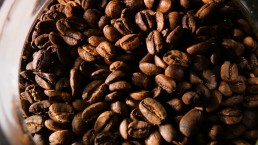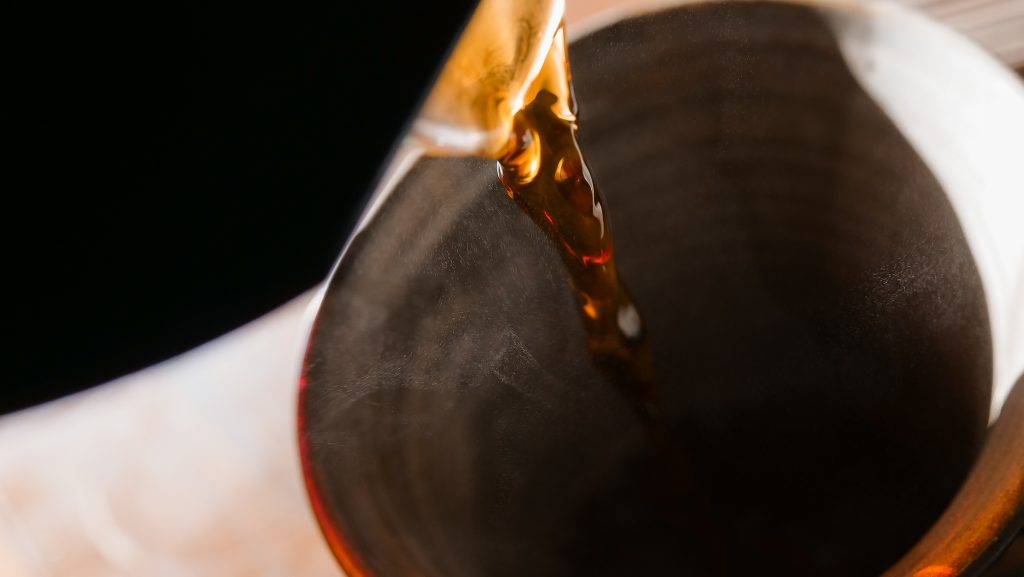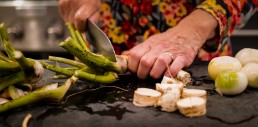Coffee: The Good the Bad and the Ugly
An Historic Global Enterprise
Coffee is one of the most ubiquitous and widely consumed beverages in the world, second only to water. The already extraordinary demand for coffee only seems to be increasing; global coffee production reached 175.35 million 60-kilogram bags as of 2020/2021, increasing from about 165 million 60-kilogram bags in 2019/2020.
Coffee drinking, and the knowledge of the coffee tree as a medicinal substance, dates back to at least the mid 15th century, where we find our first credible historical evidence pertaining to its use in the accounts of Yemini author Ahmed al-Ghaffar. The coffee tree was most likely introduced into Yemen by way of trade routes with Ethiopia from across the Red Sea. Thus, given that the coffee tree was being traded and exported from Africa, it is highly unlikely that its medicinal, recreational, and social values were only realized in the 15th century, in a country where the tree itself was not native. The use of coffee almost certainly reaches back much further than the 15th century, though specifics concerning its initial discovery by the peoples of the African continent and its use in their traditional systems of medicine and culture remain obscure.
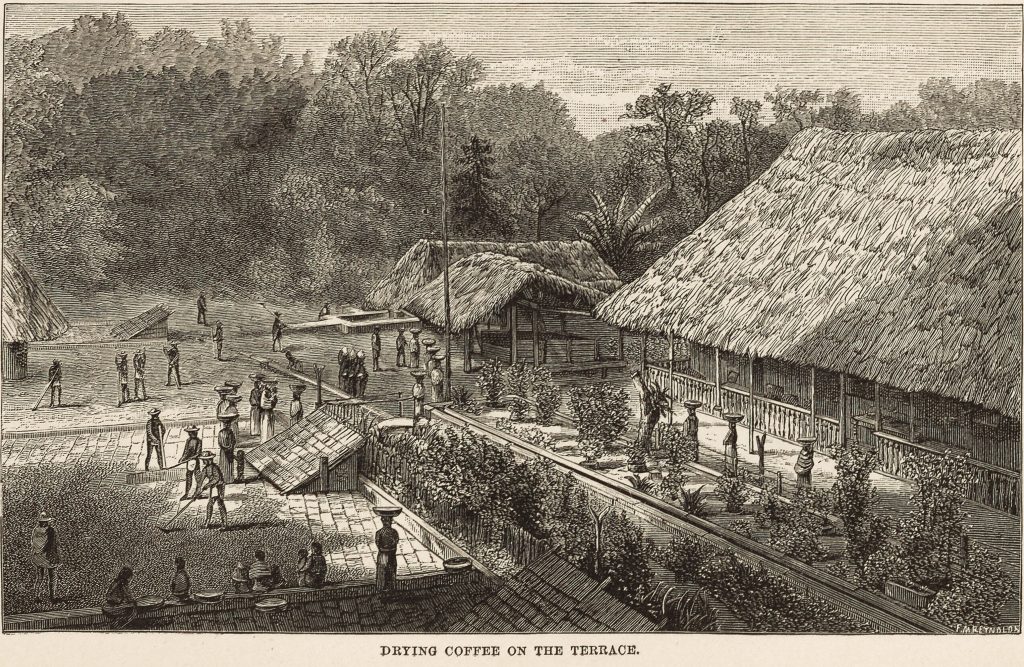
When it comes to the earliest detailed historical records concerning the use of coffee, we can look to the work of Harvard historian Cemal Kafadar, where it is revealed that the social significance of coffee in Islamic society was established by way of its use in Sufi religious rituals:
“To turn to the early history of coffee and coffeehouses, more specifically, there must have been many instances when coffee was consumed as a plant found in the natural environment of Ethiopia and Yemen, but the earliest users who regularized its consumption as a social beverage, to the best of our knowledge, were Sufis in Yemen at the turn of the fifteenth century. Evidently, they discovered that coffee gave them a certain nimbleness of the mind, which they were keen on cultivating during their night-time vigils and symposia. Thus started the long history of the appreciation of coffee as a companion to mental exercise and conviviality, particularly when one wished to stretch or manipulate the biological and social clock.”1
The Start of The Coffee House Phenomenon
It is from this point onward that coffee houses started to appear across Arabia and gradually, over the next three centuries, throughout the rest of the world. The historical significance of the coffee house is inextricably bound up with the historical significance of coffee itself; the coffee house has always served as a kind of public institution and cultural hub through which all manner of information – from the common and mundane to the revolutionary and political – was shared and disseminated amongst the population. Even today, in a world increasingly characterized by digital identities and disembodied forms of social engagement, the coffee house still serves as a place of respite, where people can turn for a semblance of embodied interpersonal interaction and exchange in an evermore alienating and depersonalizing world.
Coffee’s appearance in Europe (especially England and Germany) in the late 17th century coincided with the discovery that clocks could be controlled by harmonic oscillators. This was followed in the 18th century by a series of technological discoveries and breakthrough inventions that lead to increasingly precise clocks, and hence to a heretofore unimaginable regimentation of time itself. Is it a mere coincidence that coffee – utilized by so many for the purposes of maintaining attention and increasing stamina – came to Europe just as machine production and the Industrial Revolution, with the inhuman demands it placed on workers, led to a decline in hand production and the artisanal trades of the past? From the perspective of cultural history, coffee has a dual identity; as a tool for social conviviality and the free flow and exchange of ideas (exemplified by the institution of the coffee house), as well as a crucial ingredient in the engineering of the industrial worker, allowing for the kind of over-stimulation that is required to meet the demands of the fast paced, mechanized world of industrial society. The hegemony of standardized clock time, and the counting of seconds, minutes and hours as measures of productivity and profitability, violated the natural diurnal rhythms that human beings had always used to orient their lives. The question remains as to the extent to which coffee played a role in one of the biggest cultural shifts in recorded history.
Historical Religion and Politics
The opinion of the medical profession with respect to coffee has been divided throughout history. Coffee is exemplary when it comes to demonstrating the degree to which medical opinion can be deeply influenced and shaped by cultural and political trends and assumptions. Indeed, the medical, socio-political and religious views of coffee were at times inextricably bound up with each other, making it next to impossible to disentangle one from the other. Where does religious belief end and medical “fact” begin? We can explore this issue by taking a closer at the early history of coffee in the Islamic world, and the changing tide of opinion with respect to the most influential and powerful drink in the world, next to water itself.
In contrast to the view that the introduction of coffee into liturgical practice was a great blessing in that it allowed worshipers to better execute their devotions to God, other religious scholars argued that coffee should be outlawed insofar as it had never been mentioned in the Quran. Many of these scholars were also concerned about what they perceived to be the deleterious health consequences of coffee consumption. But this controversy is even further muddied when we stop to consider the political climate of the time. While some commentators argue that the various attempts to outlaw coffee in the Islamic world were a consequence of religious and medical opinion, the truth is more likely that coffee (and the social revolution spurred by the birth of the coffee house) was perceived as a political threat.
“Between the early 16th and late 18th centuries, a host of religious influencers and secular leaders, many but hardly all in the Ottoman Empire, took a crack at suppressing the black brew. Few of them did so because they thought coffee’s mild mind-altering effects meant it was an objectionable narcotic (a common assumption). Instead most, including Murad IV [the Ottoman sultan who issued a ban on coffee in 1633], seemed to believe that coffee shops could erode social norms, encourage dangerous thoughts or speech, and even directly foment seditious plots.”2
In what is perhaps an unexpected twist, our brief survey of the cultural and political history of coffee has revealed the extent to which many of our deeply held assumptions, sometimes taken as objective fact, in actuality rest upon a socio-political and theological underpinning of opinion and currents of dogmatic belief which colour our perception, of which we may be mostly or even totally oblivious.
PART II: Coffee as Medicine, Coffee as Poison
What is the difference between a food and a medicine? In his essay from 1803 titled ‘On the Effects of Coffee’, Samuel Hahnemann (the founder of homeopathy) set out to clarify this distinction and to warn of the deleterious effects of the unchecked consumption of medicinal substances, taking coffee as a paradigmatic example. Hahnemann writes:
“Medicinal things are substances that do not nourish, but alter the healthy condition of the body; any alteration, however, in the healthy state of the body constitutes a kind of abnormal, morbid condition. Coffee is a purely medicinal substance. All medicines have, in strong doses, a noxious action on the sensations of the healthy individual. No one ever smoked tobacco for the first time in his life without disgust; no healthy person ever drank unsugared black coffee for the first time in his life with gusto — a hint given by nature to shun the first occasion for transgressing the laws of health, and not to trample so frivolously under our feet the warning instinct implanted in us for the preservation of our life.”3
A medicine is a substance that serves to alter the state of health, whereas a food is a substance that serves to provide nourishment. When medicines are taken in excess, or when they are not properly indicated for an individual person, they can produce an abnormal or even pathological condition. Medicines can preserve life and maintain health, though they can also derange the state of health and take life away when they are given without the requisite attention or care. Food substances can likewise produce states of disease if they are eaten to excess, though the deleterious effects of foods generally take a much longer time to manifest when compared to the stronger power of medicinal substances to affect deep seated changes on the level of constitutional vitality.
While in 1803 Hahnemann condemned the use of coffee, going to so far as to argue that its unchecked consumption was the origin of many of the chronic diseases that plagued humanity, he later toned down his opinion, having developed a much more sophisticated theory of the origins of chronic diseases by way of the concept of the miasms (the 18th century precursor to our contemporary theories of epigenetics, and one of the philosophical foundations of homeopathic medical practice to this day). Nevertheless, Hahnemann was right to emphasize the extent to which medicinal substances, when treated as foods and consumed injudiciously, can exert profound effects on the state of health. This is especially true if conditions of heightened susceptibility to a given substance are at play in an individual’s constitution (think here of the example of severe allergic reactions to substances that to most people are extremely benign). Human response to coffee and to caffeine varies widely, and like any assessment of a medicinal substance, individual response patterns must always be given a higher regard than overly generalized, universal theories and pronouncements. The difference between a medicine and a poison is ultimately in the dose, and the effect of the dose is always weighed in relation to the individual to whom it is administered.
The Hahnemann of 1803 represents one extreme when it comes to thinking about coffee as medicine. A look at the medical literature on coffee, from from the 15th century to the present day, is full of contradictory and opposing points of view. Coffee was for centuries listed in the pharmacological and medical literature that herbal and Eclectic physicians relied upon, such as the Codex Medicus. Coffee remained classified as a medicinal substance in materia medica and pharmacopoeias until the twentieth century, when the use of natural medicinal substances was largely supplanted by the products of the petrochemical drug industry. Maria Letícia Galluzzi Bizzo et al. recount some of the claims made about coffee in the medical traditions of the West, emphasizing and siding with the view of coffee as a universal elixir of health (the poplar opposite of Hahnemann’s position):
“As a panacea, coffee has been prescribed as infusions, capsules, potions, or injections against a vast spectrum of diseases— from hernias to rheumatism, from colds to bronchitis. In the first half of the nineteenth century, medical controversies underlined the therapeutic use of caffeine in chronic conditions such as heart and circulation problems because of difficulties establishing the proper doses and the risk of toxicity to the heart. Nevertheless, the notion that such use would be safe prevailed. Recent research has opened new horizons regarding the use of coffee as a medicine, with discoveries of possible distinct preventive and curative applications of coffee’s substances.”4
The Coffee of Today
The medical opinions of the past are in many ways inadequate when it comes to judging the effects of coffee today. The coffee of the 1800s is not the coffee of the 21st century. Consider, for example, the question of pesticides. Only about 3% of the world’s coffee supply today is produced using organic methods, and we now know that the residues of pesticides found on coffee beans, one of the most pesticide ridden agricultural products in the world, are for the most part not destroyed by the roasting process. Many countries that produce coffee use pesticides that have been banned in North America and Europe over health and safety concerns, and a significant number of the countries which import this coffee do not have maximum residue limits (MRLs) when it comes to the pesticides that are used and can be detected on the harvested coffee beans.

Mold is yet another issue. When not stored in a temperature controlled storage facility, coffee beans are also highly susceptible to developing mold, which comes with its own host of long term adverse health effects. Even roasting techniques have a great bearing on coffee’s potential effects on one’s state of health. One study carried out by the International Association for Food Protection, for example, comes to the following ambiguous conclusion concerning the question of the carcinogenicity of coffee and how this is affected by the roasting process:
“Roasting coffee results in not only the creation of carcinogens such as acrylamide, furan, and poly-cyclic aromatic hydrocarbons but also the elimination of carcinogens in raw coffee beans, such as endotoxins, preservatives, or pesticides, by burning off. However, it has not been determined whether the concentrations of these carcinogens are sufficient to make either light or dark roast coffee more carcinogenic in a living organism.”5
There are a whole host of other socio-economic and political considerations that should be borne in mind with respect to the global coffee industry of the 21st century. Health is not a purely individual consideration; the health of your body and mind are indissociably bound up with the functioning of the larger natural and artificial systems in which you exist. We are unwitting participants in a global system of capitalist exploitation which, through the untiring impulses of profitability and expansion, inevitably leads towards the total degeneration of the natural world and the complete immiseration of its inhabitants. A sober and careful look at coffee and its economic, political, and agricultural ramifications, inevitably alerts us to a confrontation with this reality.
Capitalism, Globalization, and the Politics of Coffee Production:
The pesticide residues found in your average bag of coffee are inconsequential in comparison to the toxicity that third world coffee farmers are exposed to on a daily basis. These farmers, in addition to the dire health consequences of chronic chemical exposure that are an unavoidable part of their work, lead lives that are dictated by the brutal conditions of strenuous labour, physical exploitation and the inter-generational cycles of inescapable poverty, child labour and indentured servitude. Alice Nguyen, in an article written for The Borgen Project (a non-profit organization dedicated to addressing the global issues of poverty and hunger), unflinchingly encapsulates these issues:
“Growing coffee requires intensive manual work such as picking, sorting, pruning, weeding, spraying, fertilizing and transporting products. Plantation workers often toil under intense heat for up to 10 hours a day, and many face debt bondage and serious health risks due to exposure to dangerous agrochemicals. In Guatemala, coffee pickers often receive a daily quota of 45 kilograms just to earn the minimum wage: $3 a day. To meet this minimum demand, parents often pull their children out of school to work with them. This pattern of behavior jeopardizes children’s health and education in underdeveloped rural areas, where they already experience significant barriers and setbacks.”6
Facts like these seem to underlie the importance of Fairtrade and Organic Certification for coffee and related products, which in principle strive to ensure sustainable development, equitable trading conditions, and giving autonomy back to marginalized farmers and agricultural workers. However, consumers in the Western world must not fall into the self-congratulatory trap of thinking themselves morally superior because they are able to afford the often vastly more expensive Organic and Fairtrade Certified products that are simply outside of the economic reach of many. The reality is that, in many instances, the increased profits from organically grown coffee products do not reach the farmers and laborers themselves, but end up lining the pockets of the distributors, who in many regions of the world function in similar ways as do drug cartels.
What is more, there are the significant and rarely discussed pitfalls of introducing organic agricultural techniques to farmers who work on lands that have been treated with chemical pesticides for decades. Such agricultural land will require significant time and effort in order to be rehabilitated such that organic farming can be sustained there. This means that farmers who are already struggling to maintain their operations run the risk of falling even further into economic enslavement if they are coerced into adopting the organic methods that righteous and ecologically minded politicians, consumers, academics and other self proclaimed “experts” in the Western world preach about with moral fervour.
Consider the following story, told by the son of a soybean farmer working in El Toledo, Costa Rica. He recalls a childhood memory of the year his father was convinced by Penn State University professors to adopt organic agricultural techniques, under the promise of increased profitability and the ecological restoration of their farmland:
“The professors convinced my dad to make a wholesale change from conventional soybean farming to organic. They warned him that he might lose up to 15% of his yield, but that this would be offset by a number of factors: He could sell his soybeans for more, as they were organic. His soil would be healthier. He would spend less on chemical inputs, and thus save money. The reality was very different. Instead of losing 15% of our yield, we lost 50%. Instead of spending less money, he spent more: the gas he spent to tractor over the weeds alone outstripped his usual chemical spending.
He ended up taking a job in a factory to avoid bankruptcy. All I remember is that when I was eight, I never saw my dad: he was either weeding the soybeans or at the factory. As soon as that season ended, we went back to chemical farming.”7
Many such stories, pertaining to all manner of farming from all parts of the world, can be found if one cares to look beyond the ‘Certified Organic’ and ‘Fairtrade’ labels that one sees plastered on one’s favourite products lining the local supermarket shelves. From coffee and soybeans to chocolate and Brazil nuts and beyond, the exploitation of labourers and the degeneration of the world’s ecosystems are part and parcel of our contemporary agricultural systems of production, whether conventional or organic. Any consideration of “sustainability” must always be understood within the framework of the global capitalist economic system in which we exist. As the political and cultural theorist Mark Fisher so poignantly put it in his book Capitalist Realism: Is There No Alternative?:
“The relationship between capitalism and eco-disaster is neither coincidental nor accidental: capital’s ‘need of a constantly expanding market’, its ‘growth fetish’, mean that capitalism is by its very nature opposed to any notion of sustainability.”8
The preceding section of this article is not intended to inculcate feelings of guilt, a sentiment which only leads to a place of demoralization and further defeat. Rather, it was written out of an honest assessment of the situation in which we all find ourselves as consumers in a system which, in its vast complexity, far transcends the individual decisions that you and I make on a daily basis. It is only from a place of sober awareness that a genuine desire for a better world can be nurtured and allowed to bear fruit.
And now, with these economic, cultural and political factors in mind, let us turn to consider the detailed effects of coffee from a more purely medical perspective. A well rounded discussion of coffee requires that we adopt a multi-perspective view. Single vision is, after all, what the capitalist system of exploitation itself is based on.

PART III: Coffee’s Medicinal Effects: What Can Reliably Be Said?
Coffee is a nervine stimulant, i.e. an herb that causes excitation and stimulation of the nervous system, specifically by engaging or heightening the activity of the sympathetic nervous system. The most widely known and discussed function of the sympathetic nervous system is the mediation of the neuronal and hormonal stress response pattern known as the fight-or-flight response. The sympathetic nervous system is what allows the body to quickly react and respond to situations of threat and danger, to situations that threaten survival. But the sympathetic nervous system cannot be adequately understood if we look at it as an isolated regulatory or physiological function. The sympathetic nervous system works in concert with the parasympathetic nervous system and together make up what is called the autonomic nervous system. The autonomic nervous system regulates and controls many of the functions of the body’s internal organs. When we consider the interdependence and co-functioning of the sympathetic and parasympathetic nervous systems, then we can begin to understand that the stress response typically associated with the sympathetic nervous system is one pole or extreme of a greater homeostatic controlling mechanism which oversees the feeling and function of the human organism on many levels.
However, excessive stimulation of the sympathetic nervous system can and does result in undue consequences. Herbalist David Hoffmann explains the action of nervine stimulant herbs, and relates their functions to the excessively heightened states of excitation that characterize the frantic and overwrought patterns of 21st century existence:
“Direct stimulation of nervous tissue is not often needed in our hyperactive modern lives. In most cases, it is more appropriate to stimulate the body’s innate vitality with the help of nervine or bitter tonics. These herbs work to augment bodily harmony, and thus have a much deeper and longer-lasting effect than nervine stimulants. In the 19th century, herbalists placed much more emphasis upon stimulant herbs. It is, perhaps, a sign of our times that the world now supplies us with more than enough stimulation. When direct nervine stimulation is indicated, the best herb to use is Cola acuminata, although Paidlinia cupana, Coffea arahica, Ilex paraguayensis, and Camellia sinensis may also be used. One problem with these commonly used stimulants is their side effects; they are themselves implicated in the development of certain minor psychological problems, such as anxiety and tension. Some of the volatile oil-rich herbs are also valuable stimulants. Some of the best and most common are Rosmarinus officinalis and Mentha piperita.”9
Caffeine is the most widely recognized and studied active ingredient in coffee as well as many other stimulant herbs (such as those listed in the above quotation). But coffee also contains a wide array of other important constituents such as tannins, fixed oils, carbohydrates, and proteins, which should not be forgotten, as coffee, just like all herbs, are irreducible to their component parts. It is through the roasting process that caffeine is liberated from the raw coffee bean. Caffeine produces diuretic and stimulant effects, specifically on the respiratory, cardiovascular and central nervous systems.10 Caffeine is also an analgesic adjuvant, and hence is incorporated into a wide number of proprietary aspirin and acetaminophen preparations.11 Coffee also contains phytoestrogens, which have been subject of a great deal of scientific debate. Phytoestrogens can play a role in addressing symptoms and conditions caused by estrogen deficiency, which may be especially pronounced in premenopausal and post-menopausal women. They are also implicated in memory and learning processes and have been shown to possess anxiolytic effects. The research into the effects of phytoestrogens on human health is still ongoing, and is a fruitful and fascinating area of research. For example, consider the fact that the consumption of beer, bourbon, mescaline, cannabis, and coffee all produce phytoestrogenic effects – the relationship between psychoactivity and phytoestrogenic compounds certainly needs to be more deeply explored!
When it comes to consider possible contraindications and adverse reactions from coffee consumption, we should note that coffee, along with fried and fatty foods, chocolate and alcoholic beverages, can lead to or serve to aggravate LES dysfunction (the lower esophageal sphincter, which links the esophagus and the stomach). Obesity, pregnancy, cigarette smoking, and a structural weakness of the diaphragm known as hiatus hernia can also contribute to a weakening of the LES. If the LES fails to properly close, stomach acid can easily splash up from the stomach into the esophagus, leading to severe acid reflux and heartburn. Gastroesophageal reflux disease (commonly known by the acronym GERD) is associated with a leaking of stomach contents back into the esophagus. When there is a prolonged period of LES dysfunction, this can lead to acid and chemical damage of the esophagus, that is, to GERD.
The consumption of coffee and other caffeine containing substances can also result in headaches. The headaches that are associated with coffee consumption are often related to caffeine dependence, which can lead to significant withdrawal symptoms in some individuals. As Hoffmann writes:
“Caffeine can cause headaches by increasing the body’s expectation for it. When blood levels of caffeine drop, symptoms of withdrawal, including headache, may set in. That’s why some heavy coffee drinkers experience “morning headache” until they have that first cup of coffee. Caffeine headaches are usually experienced as a dull, throbbing pain on both sides of the head. Once the body rids itself of caffeine, the headaches disappear on their own. Such headache sufferers, however, are often unaware that their problem is due to caffeine and will continue to drink coffee, ensuring that the problem will recur.”12
We can look to the homeopathic literature to round out our consideration of the spectrum of effects that coffee can have. In homeopathy, the medicinal effects of a given substance are elaborated through clinical experience as well as through provings. A proving entails rigorous and detailed observation of the effects of a substance when administered at a sufficient dosage in its crude form and/or as a dynamic or potentized medicine (having been subjected to serial dilution and succussion or vigorous shaking), such that it produces modifications to the state of a person’s health and disposition. The fundamental principle of homeopathic prescribing is that like treats like. In other words, if a substance can cause a certain symptom on the physical, mental/emotional, or dispositional level in a relatively healthy person, then it can in like manner work to treat those same symptoms when they are expressed by a patient who comes seeking care.
Dutch Homeopath Jan Scholten describes the essence of the patient needing potentized coffee (Coffea Arabica) in the following way:
“Coffea is the ideal intellectual worker. They feel stable, focused and self-confident in their mind… They are independent and responsible, following their own plans.”13
The coffea patient often possess a great deal of stability, they are responsible, hard working, persevering, and their actions are well organized and carefully planned. Coffee in its crude form can serve to promote these qualities in people, so it is no wonder that many rely upon it in a culture which emphasizes work, productivity, and efficiency. Scholten explains that the mind of the coffea patient can be active and full of ideas. They can have clear, active, and lucid thoughts, are fast and easy learners with great comprehension skills. They can experience a rush of thoughts, a heightened sense of judgment and sharp and acute states attention. They tend to be quite ambitious people, with a strong and even overpowering need to achieve. They can feel that they must work as hard as possible to fulfill their own expectations, as well as the expectations of their parents (especially the father). Given the great demands that they place upon themselves, and the seriousness with which they approach their assigned tasks and responsibilities, the coffea patient can experience states of pronounced nervous agitation, excitement, exaltation, hilarity, restlessness and irritability – think of the states associated with and over-excitation of the nervous system.
Oversensitiveness is a keynote of this remedy, and all of the senses – sight, hearing, smell, taste, and touch – can be greatly heightened. Eating and drinking are things that they do quickly and in a hurried way, as befits their general tendency towards restlessness, hurry, and hyperactivity. The coffea patient may also be the type of person who feels that they cannot live up to the pronounced and unrelenting demands and expectations that they are faced with, and hence suffer from a lack of self confidence, which is improved through the use of stimulants. They feel things intensely, and can have a tendency to exaggerate their emotions and be highly susceptible to the impressions to which they are exposed. Emotional excesses, from extraordinary states of pleasure, optimism, and joy (coffea is a remedy for ailments from excessive joy) to the polar opposite of pronounced despair and despondency, with sharp anger and rudeness. When in this latter state, they can throw everything away, disposing of all that they have been given – in contrast, they can also be excessively clingy, and want to desperately hold on to people and their possessions. They feel pain intensely, and their anguish can run deep. Coffea can have the following delusions: “paradise, magnificent grandeur, beautiful world, heavenly scenes.” They experience states of benevolence and idealism, with a desire to perform good deeds, and veneration for the Supreme Being. Coffea may be prescribed for “ailments from vexation, mortification, frustration; discords between relatives, friends; hurry; anticipation; sudden emotions, pleasurable surprises.” The treatment of a variety of headaches, neuralgic pains and spasmodic afflictions, heart palpitations, digestive disturbances, and states of insomnia may also be addressed with coffea.
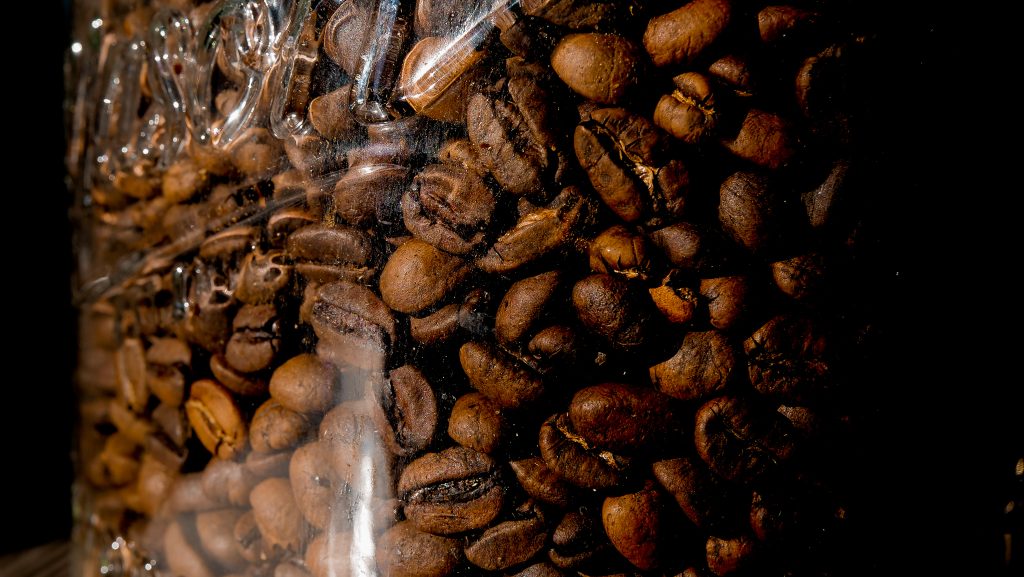
In Conclusion…
From our explorations into all things coffee, we may conclude that it is, perhaps more than any other substance in existence, paradigmatic of the culture of modernity. From controversies regarding altered states of consciousness to the regimentation of life brought about through the reign of clock time, from the exploitation of agricultural workers in the 3rd world to meet the needs of the Western consumer to controversies in the medical profession concerning the difference between medicinal and poisonous substances, coffee is both practically and symbolically encoded with many of the most pressing concerns of the culture of modernity. Our investigations into coffee have served to reveal the myriad ways in which everyday substances are always already embedded within and serve to reflect the complex cultural, economic, and political realities in which we exist. The tremendous extent to which plants play a role in shaping human culture through modification of the patterns of human thought and behaviour has also become clear. We have long ago reached the point that our world would be unrecognizable without coffee.
Footnotes:
1 Cemal Kafadar. ‘How Dark is the History of the Night, How Black the Story of Coffee, How Bitter the Tale of Love: The Changing Measure of Leisure and Pleasure in Early Modern Istanbul’ in Medieval and Early Modern Performance in the Eastern Mediterranean, ed. by Arzu Öztürkmenand Evelyn Birge Vitz, lmems 20 (Turnhout: Brepols, 2014).
2Mark Hay. ‘In Istanbul, Drinking Coffee in Public Was Once Punishable by Death.’Atlas Obscura, May 22, 2018. https://www.atlasobscura.com/articles/was-coffee-ever-illegal
3 Samuel Hahnemann, The Lesser Writings Of Samuel Hahnemann, ed. and trans. R.E. Dudgeon. New York: William Radde, 1852. Pg. 392.
4 Maria Letícia Galluzzi Bizzo et al. ‘Highlights in the History of Coffee Science Related to Health.’ Science Direct, 7 November 2014. https://www.sciencedirect.com/science/article/pii/B9780124095175000024
5 Joseph Kim et al. ‘Safest Roasting Times of Coffee To Reduce Carcinogenicity.’ PubMed, 1 June 2022. https://pubmed.ncbi.nlm.nih.gov/35226750/#:~:text=Abstract,or%20pesticides%2C%20by%20burning%20off.
6 Alice Nguyen. ‘Bitter Origins: Labor Exploitation in Coffee Production.’ Borgen Project, 24 September, 2020. https://borgenproject.org/labor-exploitation-in-coffee-production/
7 Brian Stoffel. ‘Urban Elites, Organic Farming & The Hypocrisy of No Skin-In-The-Game’. 14 June, 2017.
https://medium.com/@stoffel.brian/urban-elites-organic-farming-the-hypocrisy-of-no-skin-in-the-game-b9f95b655686
8 Mark Fisher. Capitalist Realism: Is There No Alternative? Oregon: Zero Books,2009. Pg. 18-19.
9 David Hoffmann. Medical Herbalism. Vermont: Healing Art Press, 2003. Pg. 519.
10 Ibid, pg. 124.
11 Ibid.
12 Ibid, pg. 365.
13 Jan Scholten. ‘Coffea Arabica.’ QJURE (undated publication). https://qjure.com/remedy/coffea-arabica-2/
Illustrations/Images:
- Illustration: Novel “Coffee: From Plantation to Cup. A Brief History of Coffee Production and Consumption” 1881 [x]
- Photos provided by Serena Mor
Pat’s Top Ten Super Foods & Herbs
What is a Super Food?
I’m sure we’d all like to think of a ‘magic bullet’ that could take care of all our health issues, which is why the title of this article is appealing: eat these foods or herbs and you will be well.
The fact is, all whole, organic, unprocessed foods are super foods. If we eat a variety of brightly coloured fruits and vegetables along with whole grains, nuts, seeds, legumes, coldwater fish and herbs and give chemicals and processed or fast foods a wide berth, we will feel better, have more energy and will maintain a healthy body weight.
Still, it is handy to have a short list of must-have foods and herbs that we know we can turn to for essential nutrients and maximum health benefits. My list boasts foods that have been proven to offer vital phytonutrients for helping to ease the following health benefits:
- Lower or help regulate blood sugar levels
- Help regulate metabolism and burn body fat
- Help protect the heart
- Help prevent cancer
- Detoxify vital organs
- Lower blood pressure
- Prevent or reduce inflammation
- Aid digestion
Pat’s Top Ten
It is known that the everyday choices we make have long-term effects on our health, and in order to begin to see the benefits listed above, you will need to include the following foods in your daily eating pattern. It’s time to ‘spring clean’ your diet by eliminating harmful high fat, low nutrient foods and replacing them with super foods everyday:
- Cruciferous vegetables
- Dark-skinned berries
- Alliums
- Herbs and spices
- Fatty fish
- Nuts
- Legumes
- Dark chocolate
- Seaweed
- Seeds
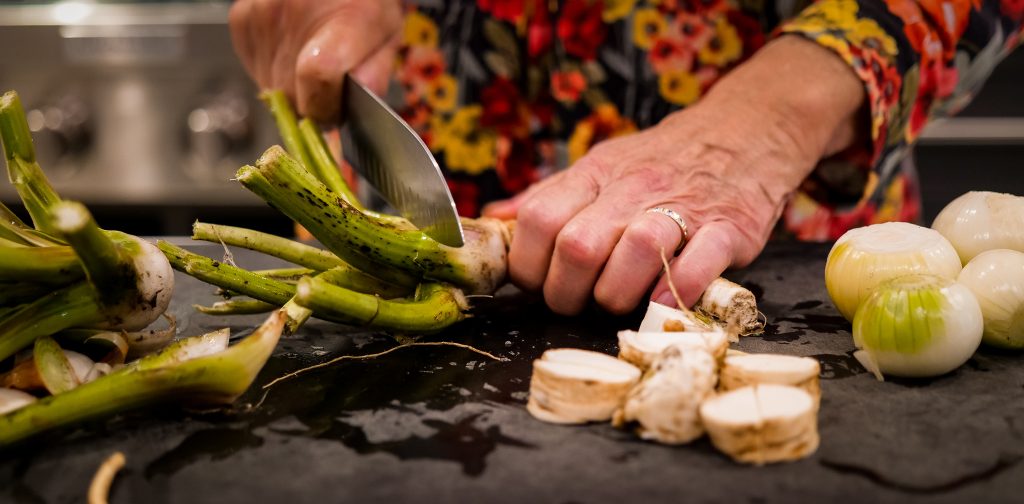
Super Food Breakdown and Recipes
Cruciferous Vegetables
Brussels sprouts, cabbage, cauliflower, broccoli rabe – contain a powerful range of disease fighters. Their Endoles and sulforaphane may increase enzymes that lower the incidence of colon and lung cancers.
My Advice: eat these foods raw and at least three times per week, everyday is ideal.
Asparagus and Cauliflower Salad Recipe:
Ingredients:
- 1 tablespoon avocado or olive oil
- 1 onion, chopped
- 2 cloves garlic, chopped
- 2 tablespoons Herb Seasoning Paste or Spring Pesto (recipes below)
- 2 cups fresh asparagus pieces
- 1 cup thinly sliced cauliflower
- ½ cup shredded carrots
- ¼ cup raisins or chopped dates
- 1 tablespoon sea salt and freshly ground pepper
- 1 cup, lightly packed baby spinach, lightly steamed
Method:
1. In a wok or skillet, heat oil over medium-high heat. Add onion and cook, stirring frequently for 5 minutes or until soft and lightly colored. Add garlic and paste and cook, stirring constantly for 1 minute. Add asparagus and cauliflower and mix well to coat with onions and spices. Cook, stirring constantly for 3 to 5 minutes or until vegetables are crisp-tender.
2. Remove from heat and stir in carrots and dates. Season to taste with salt and pepper. Serve warm over spinach.
Makes 4 to 6 servings
Dark Skinned Berries
Blueberries, blackberries, acai berries – their high concentrations of anthocyanins and phenolic pigments (which make them dark blue, red or purple in colour) give them exceptional antioxidant, anti-diabetic and heart protective properties.
My Advice: include raw (fresh or frozen) dark-skinned berries at least once daily in meals.
Black Berry Smoothie Recipe:
Ingredients:
- ½ cup pomegranate juice
- 1 tablespoon avocado oil
- ½ cup fresh or frozen blueberries
- ½ cup fresh or frozen blackberries
- ¼ cup frozen acai berries or raspberries
- 4 beet top leaves or spinach
- 1 tablespoon chia seeds
- ¼ teaspoon ground cinnamon
Method:
1. In a blender, combine juice, oil, blueberries, blackberries, acai berries, green leaves and chia seeds. Blend on high until smooth. Pour into 2 glasses and garnish each with cinnamon.
Makes 2 servings
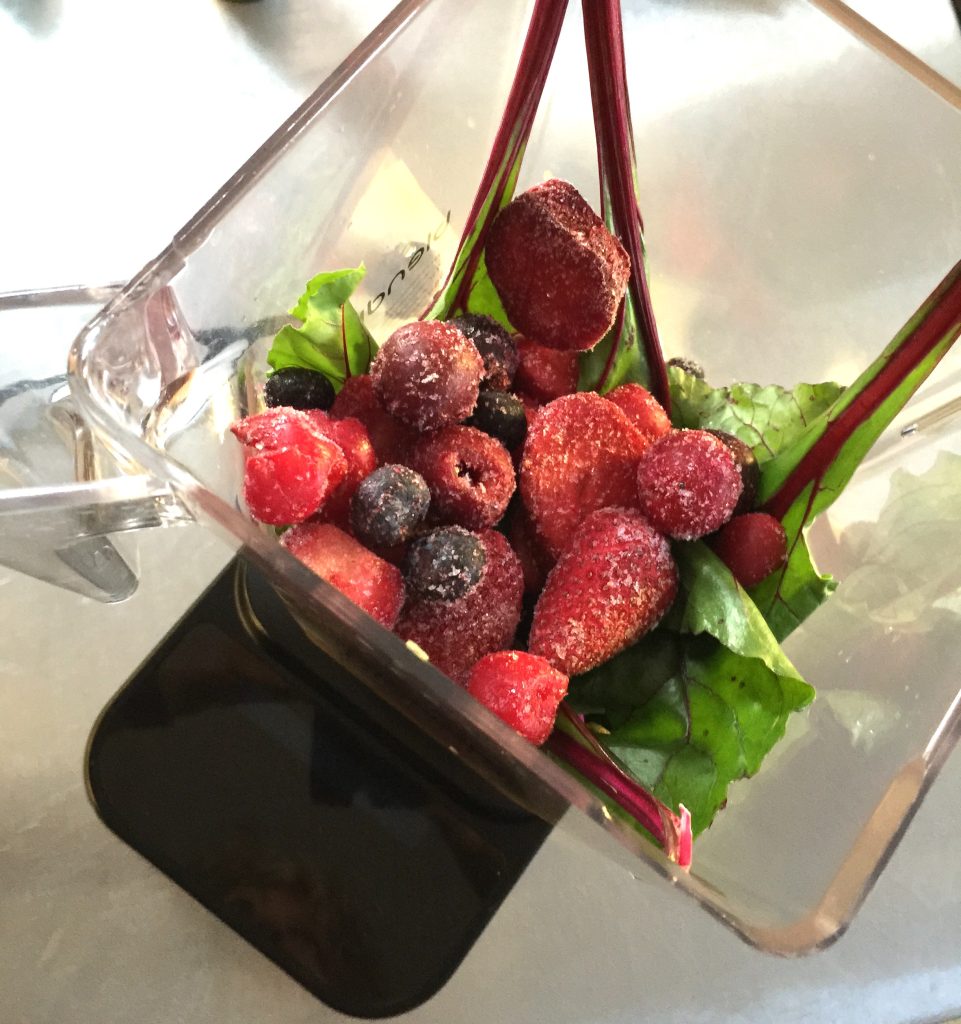
Alliums
Leeks, garlic, onions, shallots. With garlic the hero of the bunch, alliums help to protect against prostate, stomach and colon cancer; lower blood pressure, blood sugar and cholesterol levels; and are antibacterial along with other benefits.
My Advice: eat raw garlic once a day and include one other allium in a daily meal.
Leek, Garlic and Onion Tart Recipe:
Ingredients:
10-inch (3 L) spring form pan or round tart pan, lightly oiled
Potato Base:
- 3 cups thinly sliced, potatoes
- 1 cup thinly sliced, peeled sweet potato
- 3 tablespoons honey mustard
- 2 tablespoons olive oil
- 1/2 teaspoon salt
- Freshly ground pepper
Topping:
- 1/4 cup sliced leek, white and tender green parts
- 4 cloves garlic, slivered
- 3 cups thinly sliced onions (about 3 onions)
- 3 tablespoons Herb Seasoning Paste or Spring Pesto (recipes below)
- 1/4 cup freshly grated Parmesan cheese
Method:
Preheat oven to 375°F (190°C)
1. Potato Base: In a large bowl, toss potatoes with mustard and oil. Spread in bottom of prepared pan. Press potatoes with the back of a spoon to compress. Sprinkle salt and pepper over top.
2. Topping: In the bowl used for the potatoes, toss leek, garlic, and onions with Herb Paste. Spread evenly over potato base. Bake in preheated oven for 40 minutes or until potatoes are tender and onions are golden. Sprinkle Parmesan over top and bake for another 3 minutes or until cheese is lightly browned. Transfer to a cooling rack and let stand for 10 minutes before serving.
Makes 4 to 6 servings
Herbs and Spices
Thyme, rosemary, turmeric, ginger, cayenne, cinnamon – most fresh green herbs contain antioxidant properties along with other healing benefits specific to the herb; dandelion and burdock leaves are cleansing; spices such as cinnamon, cloves, and nutmeg contain powerful phytonutrients that regulate and affect body functions.
My Advice: eat fresh green herbs with 2 meals each day and cook with fresh ground spices (season dishes with 1 tablespoon Spring Pesto, below) every day.
Herb Seasoning Paste Recipe:
Ingredients:
- 1 cinnamon stick (2-inches), crushed
- 1 tablespoon whole yellow or brown mustard seeds
- 1 tablespoon whole coriander seeds
- 2 dried cayenne peppers, cut into pieces
- ¼ cup chopped fresh green herbs (thyme, oregano, dandelion, parsley or burdock leaves)
- 2 cloves garlic
- 1 piece (1-inch) fresh ginger, peeled
- 1 teaspoon ground nutmeg
- 1 tablespoon avocado or olive oil
- 1 tablespoon brown rice syrup
Method:
1. In a spice grinder or mortar (using pestle) chop or pound cinnamon, mustard, coriander and peppers until consistently ground (fine or coarse as desired). Add garlic and ginger and blend or pound to a thick paste. Add nutmeg, oil and rice syrup and mix until well blended and smooth. Transfer to a small jar. Label and store in the refrigerator for up to 2 weeks.
Makes 1/2 cup
Fatty Fishes
Wild salmon and sardines are one of the best sources of omega 3 fatty acids. Avoid farmed fish because wild-caught fish eat krill and other wild foods that contribute to the quality of their flesh; they are lower in mercury and high in vitamin D and have not been fed grain and antibiotics.
My Advice: eat fatty fish twice a week.
Braised Salmon and Kale with Red Lentils Recipe:
Ingredients:
- 1 tablespoon avocado or olive oil
- 1 small red onion, chopped
- 1 tablespoon Herb Seasoning Paste (recipe above) or Spring Pesto (recipe below)
- 2 cups chopped kale (still wet from washing)
- 4 wild salmon fillets (4 oz/125 g each), skin on one side
- 1 can (19 oz/540 mL) red lentils rinsed and drained
Method:
1. In a skillet or wok, heat oil over medium-high heat. Add onion and seasoning paste and cook, stirring frequently for 5 minutes or until onions are soft and lightly coloured. Add kale and toss to coat with onions. Place salmon over top, skin side up. Cover, reduce heat to low and cook for 10 to 15 minutes or until salmon is opaque and flakes easily with a fork. Remove skin from salmon and remove fillets to a platter. Toss lentils with kale mixture and heat through.
Makes 4 servings
Nuts
All nuts, especially walnuts and almonds are great sources of antioxidants, vitamin E, selenium and magnesium, and of all nuts, walnuts are highest in alpha-linolenic omega-3 fatty acids, which lower LDL (bad) cholesterol.
My Advice: eat a handful of nuts every day to help reduce the risk of heart disease.
Spring Pesto Recipe:
Ingredients:
- ¼ cup walnuts or almonds
- 2 tablespoons sesame or flax seeds
- 4 cloves garlic
- 1 cup chopped fresh dandelion leaves
- 1 cup fresh parsley
- 2 tablespoons fresh rosemary or thyme
- ¼ cup grated Parmesan cheese
- 1 cup olive oil
- sea salt
Method:
1. In a blender or food processor, chop walnuts, flax seeds and garlic. Add dandelion, parsley and rosemary and start motor. Add olive oil slowly through opening in feed tube and process until pesto is desired consistency. Season to taste.
Makes 2 cups
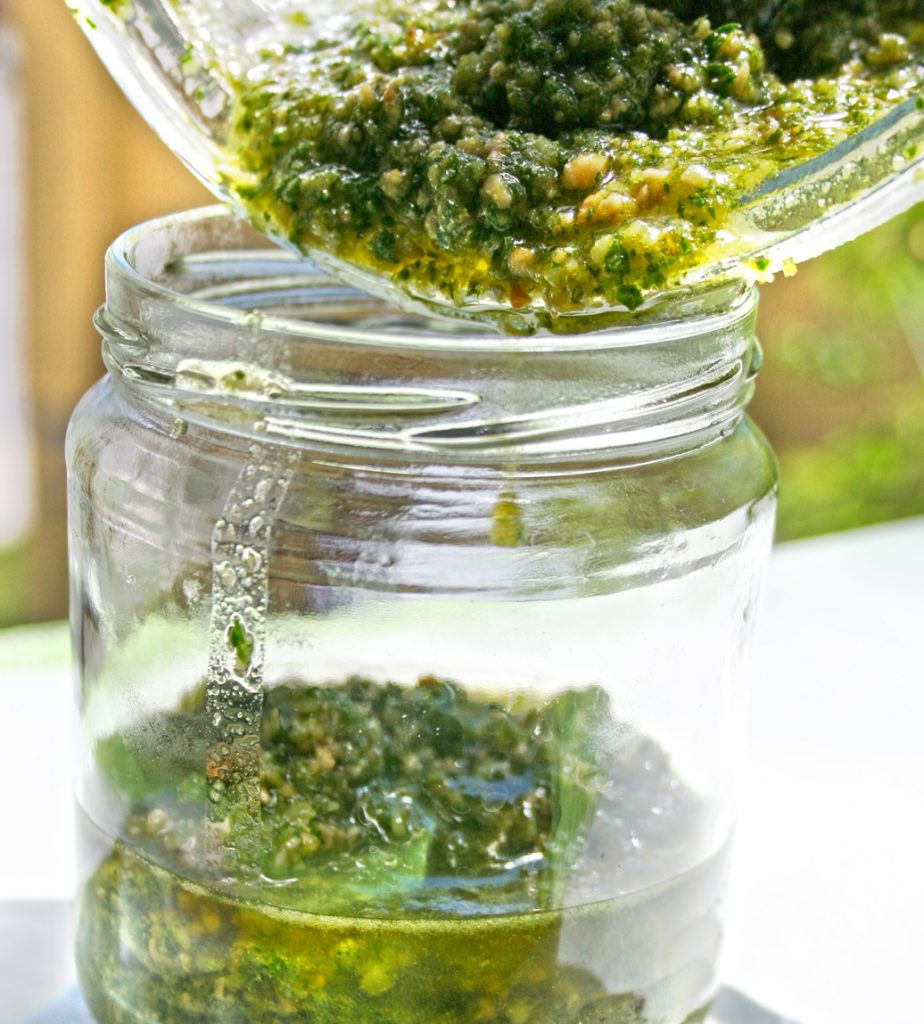
Legumes
Dried peas, beans, lentils – a good plant protein; high in fiber, associated with lower risks of heart disease, diabetes, obesity and cancer.
My Advice: eat legumes three times per week, more often if you are vegetarian/vegan.
Ancho Chocolate and Sweet Potato Stew Recipe:
Ingredients:
Chile Seasoning:
- 3 dried ancho chiles (or 1 teaspoon chili powder)
- 1 tablespoon chopped fresh oregano
- 1 teaspoon ground cumin
- 1/2 teaspoon ground cinnamon
- 2 teaspoons sea salt
Stew:
- ½ head cauliflower, trimmed and cut into ¼-inch pieces
- 4 tablespoons avocado oil, divided
- 1 red onion, chopped
- 4 cloves garlic, chopped
- 1 sweet potato, trimmed and cut into large dice
- ½ rutabaga, trimmed and cut into small dice
- 2 carrots, coarsely chopped
- 1 can (28 oz /796 mL) diced tomatoes and juice
- 1 stick (2-inch) cinnamon
- 2 cups vegan stock or water
- 1 oz (30 g) unsweetened dark chocolate, grated
- 1 can (14 oz/398 mL) pinto beans, drained
- 2 cups coarsely chopped kale, spinach or Swiss chard
Method:
1. Make Chile Seasoning: slice chilies in half lengthwise and remove stems and seeds. Toast chilies: heat a small dry skillet over medium heat. Add chilies, pressing down with tongs for 1 minute, turning over and toasting for 30 seconds on other side. Let cool and slice into 4 pieces. Pulse in a spice grinder until finely ground. Transfer to a small bowl and stir in oregano, cumin, cinnamon and salt.
2. Preheat oven to 375 F and line a rimmed baking sheet with parchment paper. Arrange cauliflower in a single layer on the sheet and drizzle with 2 tablespoons of oil. Bake in preheated oven for about 30 minutes or until lightly browned and crisp-tender. Remove from oven and set aside.
3. Meanwhile, heat remaining oil in a large soup pot over medium heat. Add onion and cook, stirring frequently for 5 minutes. Add garlic and Chile Seasoning and cook, stirring frequently for a minute or two.
4. Stir in sweet potato, rutabaga, carrots, tomatoes and their juice, and cinnamon stick. Bring to a boil and cook, stirring occasionally for about 6 minutes or until the mixture is thickened slightly.
5. Add stock, increase heat to high and bring to a boil. Lower heat and simmer, covered for about 30 minutes or until vegetables are crisp-tender.
6. Add chocolate and stir until it is melted into the mixture. Stir in cauliflower, beans and kale and simmer until heated through, about 3 minutes.
Ladle into 6 serving bowls.
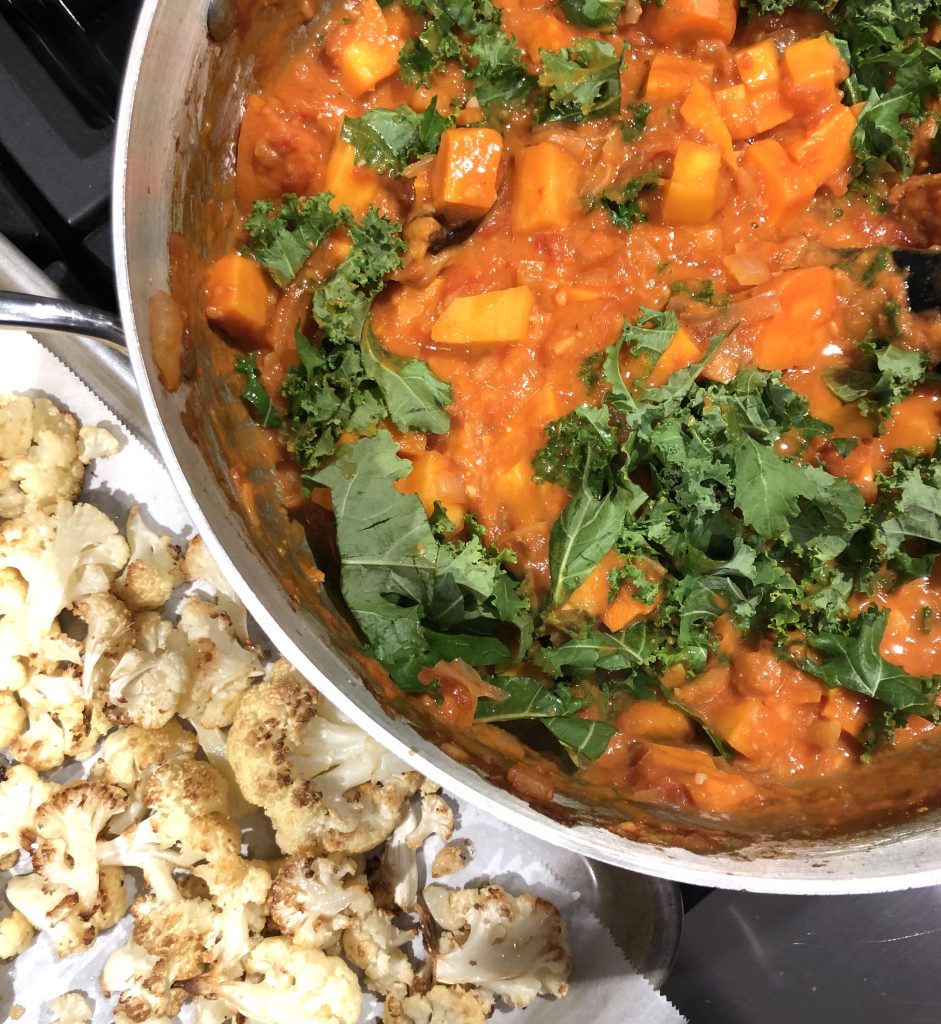
Dark Chocolate
70% cocoa or higher – high in antioxidants for anti-aging; flavonoids that prevent clogged arteries and lower blood pressure; and magnesium.
My Advice: indulge in one small square (1/2 oz/15 g) of the best quality dark chocolate (as high in cocoa as you can comfortably enjoy) every day.
Ancho Chocolate Chile (see recipe, above)
Seaweed
Arame, hijiki, kelp, kombu, nori, wakame – detoxify the body and help prevent assimilation of heavy metals; may have anticancer effects; individual seaweed varieties have varying levels of calcium, iodine, potassium and iron.
My Advice: eat seaweed once or twice per week and eat kombu or dulse raw (crushed and sprinkled over breakfast cereals, salads and main course dishes) every day.
Shiitake Mushroom Nori Rolls Recipe:
Ingredients:
- 3 tablespoons avocado or olive oil, divided
- 3 green onions, thinly sliced
- 1 zucchini, peeled and diced
- ½ cup sliced shiitake mushroom caps
- ¼ cup chopped almonds
- 3 tablespoons sesame seeds
- 1 tablespoon maple syrup
- 1 tablespoon tamari or soy sauce
- 1 tablespoon Spring Seasoning Paste (recipe above)
- 1 cup cooked Japanese sticky rice
- 2 sheets dried nori
Method:
1. In a skillet or wok, heat 2 tbsp of the oil over high heat. Swirl to coat the base and sides. Add onions, zucchini and mushrooms and cook, stirring constantly for 4 minutes. Stir in almonds, sesame seeds, brown rice syrup, tamari and seasoning paste. Transfer to a bowl and let cool. Toss rice with mushroom mixture.
2. Lay one sheet of nori out on a sushi mat or clean tea towel. Spoon rice mixture along the long side of the sheet and roll up. Moisten the long end to close the roll. Set aside and fill and roll the remaining nori sheet.
Makes 2 rolls, about 12 slices
Seeds
Flax, chia, pumpkin, sunflower and sesame seeds – sesame seeds enhance absorption of vitamin E and help lower cholesterol; pumpkin seeds contain beta-sitosterol that offers some benefit for prostate hyperplasia (BPH); sunflower seeds help lower cholesterol and may lower the risk of heart disease.
My Advice: eat 2 to 3 tablespoons of seeds (whole sesame seeds if you can find them; pumpkin if you are male) every day.
Power Oat Bars Recipe:
Ingredients:
11-by 7-inch (2L) baking pan
- 1 cup coarsely chopped walnuts
- ½ cup sesame seeds
- 2 cups granola cereal
- 1 cup large flake rolled oats
- 1 cup dried cherries or cranberries
- ¼ cup whole flaxseeds
- 2 tablespoons whole chia seeds
- 1 tablespoon freshly ground sea salt
- ½ cup brown rice syrup or honey
- 2 tablespoons coconut oil
- 2 teaspoons pure vanilla extract
Method:
1. In a large bowl, combine walnuts, sesame seeds, granola, oats, cherries, flaxseeds, chia seeds, and sea salt.
3. In a saucepan, heat brown rice syrup over medium-high heat until lightly simmering. Remove from the heat and stir in the coconut oil and vanilla. Stir until the coconut oil is dissolved. Pour over grain mixture. Press into the prepared baking pan and set aside for 15 minutes. Cut the mixture into 2 x 2-inch squares. Store at room temperature for up to 2 weeks or in the refrigerator for up to a month.
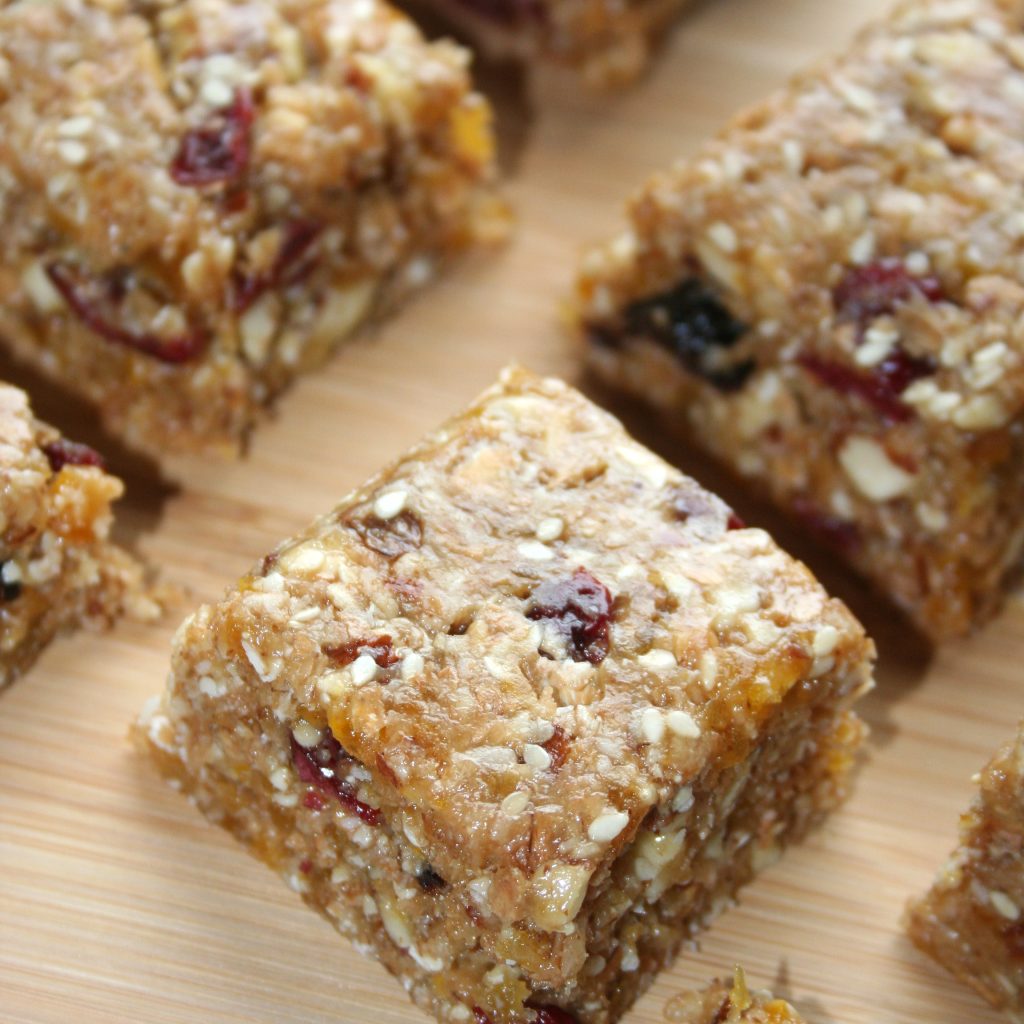
Enjoy!
Have fun trying new recipes and incorporating more super foods into your every-day life!
Recipe photos provided by Pat Crocker
Header photo provided by Serena Mor

